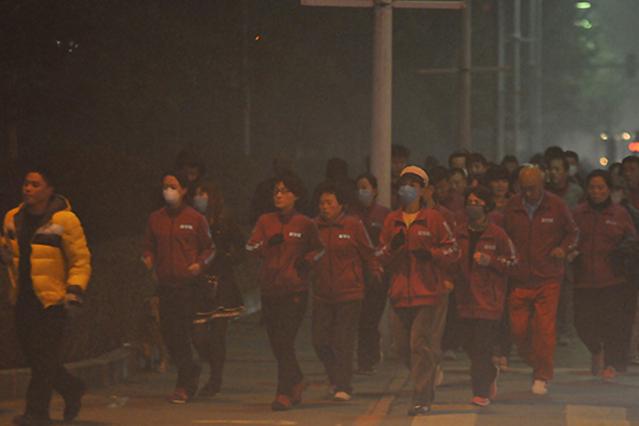

 |
Local residents jog on street amid heavy smog for physical exercise, in Shenyang, Liaoning province, in the evening on Nov 9, 2015. [Photo/IC] |
"Fairyland or doomsday?" China's state-backed news agency asked Monday.
Sure looks like doomsday.
Fairyland or doomsday? Heaviest #smog this year shrouds NE Chinese city of Shenyang, PM 2.5 hit over 1400 pic.twitter.com/GLo82Abk4R
— China Xinhua News (@XHNews) November 9, 2015
Walking the line between cluelessness and dark comedy, Xinhua's English-language Twitter account on Monday called global attention to what may be the worst air pollution reading since China started monitoring and publishing data on the density of toxic particles, or PM 2.5, in 2013.
The thick, toxic air shrouded the city of Shenyang for much of the weekend, turning day to smoggy night and severely limiting visibility. Photographs from the city show buildings enveloped by airborne grit and commuters caught in an otherworldly gray haze.
Thick smog blankets NE. China’s Liaoning Province; visibility in Shenyang city within 100 meters pic.twitter.com/sv4qll9iNo
— CCTVNEWS (@cctvnews) November 8, 2015
Data released by the Shenyang Environmental Protection Agency on Sunday showed that the density of toxic particles was more than 1,000 micrograms per cubic meter. (The World Health Organization says an average reading of 25 over 24 hours is safe.)
Local officials said the pollution levels topped 1,200. Xinhua put the figure at 1,400. The U.S. Consulate in Shenyang, which publishes regular updates, registered the air as "beyond" — meaning, off the chart.
11-08-2015 17:00; PM2.5; 810.0; 704; Beyond Index (at 24-hour exposure at this level)
— ConGenShenyang (@Shenyang_Air) November 8, 2015
China's pollution problem is not new. But despite some signs of hope, air pollution continues to plague much of the country, particularly the northeast.
One recent study, published in the journal PLOS One, found that air pollution is linked to about 1 in 6 premature deaths, killing 1.6 million Chinese a year.
In China, PM 2.5 levels tend to peak during the winter months, and local officials linked the pollution in Shenyang to the city recently switching on the heat.
Air pollution in Shenyang, NE China's biggest city, hit nearly 50 times WHO safe level https://t.co/PZdqU0LLfu pic.twitter.com/WO9snRPi1X
— China.org.cn (@chinaorgcn) November 9, 2015
But the advent of winter and the start of heating season come as no surprise, which led many Chinese to question why officials did not do more to prevent the seasonal surge.
On Chinese social media, people vented about the even-worse-than-usual weather, worrying about the prospect of lung cancer and lamenting the limits of the state response. "Waiting for the wind to change is how the government deals with air pollution," one person wrote.
China's leaders say they share the concern and have vowed, repeatedly, to wage war on bad air. Last November, as China welcomed world leaders to an APEC summit, President Xi Jinping conceded that he checked pollution readings every day.
"These days the first thing I have been doing after getting up in the morning is check how Beijing's air quality is and hope there is less smog so that all these guests from distant places will feel more comfortable," he said in a televised speech.
His team managed to clear the air for the visiting dignitaries.
Not so in Shenyang.
© China Daily Information Co